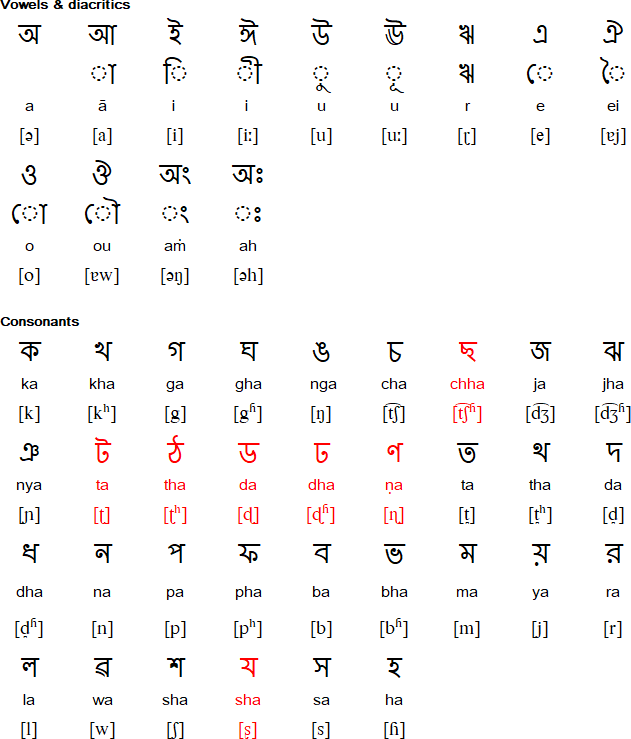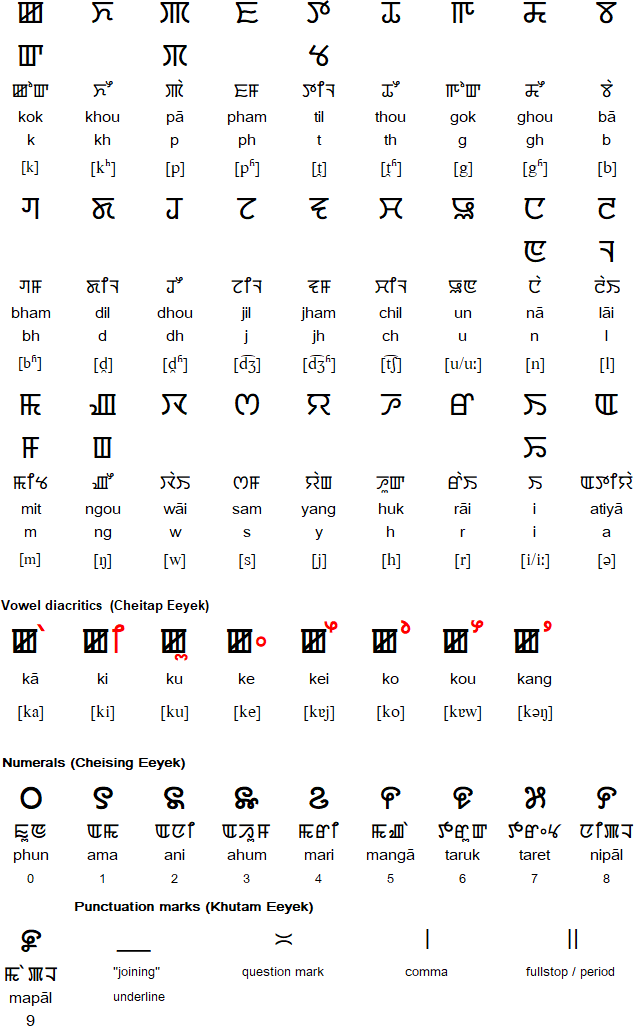Manipuri is a member of the of Kuki-Chin-Naga branch of the Tibeto-Burman language family. It is spoken by about 1.8 million people, mainly in the state of Manipur in the northeast of India. There are also Manipuri speakers in the states of Assam, Tripura and Nagaland, and in nearby parts of Myanmar and Bangladesh.
Manipuri is the official language of Manipur, where it used as a lingua franca, and one of the 22 scheduled languages of India. It is also known as Meitei, Meitheir or Meetei.
Manipuri has been written with the Old Manipuri script, the Bengali alphabet, the modern Manipuri / Meitei script, and with the Latin alphabet.
The Old Manipuri script developed sometime during the 11th century and was used until the 18th century. It origins are uncertain as many historical documents were destroyed at the beginning of the 18th century during the reign of King Pamheiba.
Between 1709 and the middle of the 20th century, the Manipuri language was written with the Bengali alphabet. During the 1940s and 50s, Manipuri scholars began campaigning to bring back the old Manipuri script. In 1976 at a writers conference all the scholars agreed on a new version of the alphabet containing a number of additional letters to represent sounds not present in the language when the script was first developed. The current Manipuri script is a reconstruction of the ancient Manipuri script.
Since the early 1980s a modernized version of the Manipuri alphabet as been taught in schools in Manipur, and education through Manipuri is available in schools and universities in Manipur.

Note: the letters highlighted in red are not generally used in Manipuri.

Download script charts for Manipuri alphabets (Excel)
মিওইবা খুদিংমক পোকপা মতমদা নিংতম্মী, অমদি ইজ্জৎ অমসুং হক মান্ননা লৌজৈ । মখোই পুম্নমক ৱাখল লৌশিং শেঙই, অফ ফত্তা খঙই, অদুনা অমনা অমগা লোইনবদা মচীন মনাওগুম্না লোইনগদবনি ।
ꯃꯤꯑꯣꯏꯕ ꯈꯨꯗꯤꯡꯃꯛ ꯄꯣꯛꯄ ꯃꯇꯝꯗ ꯅꯤꯡꯇꯝꯃꯤ, ꯑꯃꯗꯤ ꯏꯖꯖꯠ ꯑꯃꯁꯨꯡ ꯍꯛ ꯃꯥꯟꯅꯅ ꯂꯧꯖꯩ ꯫ ꯃꯈꯣꯏ ꯄꯨꯝꯅꯃꯛ ꯋꯥꯈꯜ ꯂꯧꯁꯤꯡ ꯁꯦꯡꯏ, ꯑꯐ ꯐꯠꯇ ꯈꯪꯏ, ꯑꯗꯨꯅ ꯑꯃꯅ ꯑꯃꯒ ꯂꯣꯏꯅꯕ ꯃꯇꯝꯗ ꯃꯆꯤꯟ ꯃꯅꯥꯎꯒꯨꯝꯅ ꯂꯣꯏꯅꯒꯗꯕꯅꯤ ꯫
míːójbə kʰud̯íŋmək pókpə mət̯ə̀md̯ə níːŋt̯ə̀mmi, əməd̯i iːdʒət əməʃùng hə́k màːnənə lɐ̀jdʒɐ̀j. məkʰój púmnəmək wakʰə̀l lə̀wʃiŋ ʃèŋi, əpʱə̀ pʱə́ːt̯ə kʰə́ŋi, əd̯unə əmənə əməgə lòjnəbəd̯ə mət͡ʃìn mənáwgùmnə lójnəgəd̯əbəni'.
Mioiba khudingmak pokpa matamda ningtammi amadi ijjat amasung hak mānnana leijei, makhoi pumnamak wākhal loushing shengi, apha phatta khangi, aduna amaga amaga loinabada machin manāogumna loinagadabani.
All human beings are born free and equal in dignity and rights. They are endowed with reason and conscience and should act towards one another in a spirit of brotherhood.
(Article 1 of the Universal Declaration of Human Rights)
Some material and corrections provided by Wolfram Siegel, Athouba Chingakham and Michael Peter Füsutumum.
Information about Manipuri | Manpuri script (Modern) | Manpuri script (Old) | Meetei Yelhou Mayek | Phrases | Numbers
Information about Manipuri
https://en.wikipedia.org/wiki/Meithei_language
https://www.ethnologue.com/language/mni
http://manipuri.freeservers.com/
http://eyek.e-pao.net/tamba/
Manipuri phrases
http://manipurian.blogspot.co.uk/2014/03/learn-basic-manipuri-languages.html
http://www.e-pao.net/epPageExtractor.asp?src=education.Learn_Manipuri.html
http://www.jamia-physics.net/manipuri/basic.html
Bawm, Biete, Chiru, Falam, Hakha, Karbi, Kom, Mizo, Mongsen Ao, Paite, Rongmei, Tedim, Thadou, Zeme, Zotung, Zou
Atong, Bengali, Bishnupriya Manipuri, Bodo, Bhumij, Chittagonian, Garo, Hajong, Karbi, Kharia, Khasi, Koch, Koda, Kokborok, Kurmali, Malto, Manipuri, Mundari, Noakhailla, Rangpuri, Sadri, Santali, Sylheti, Toto, Tanchangya
Page last modified: 19.11.24
[top]
You can support this site by Buying Me A Coffee, and if you like what you see on this page, you can use the buttons below to share it with people you know.

If you like this site and find it useful, you can support it by making a donation via PayPal or Patreon, or by contributing in other ways. Omniglot is how I make my living.
Note: all links on this site to Amazon.com, Amazon.co.uk
and Amazon.fr
are affiliate links. This means I earn a commission if you click on any of them and buy something. So by clicking on these links you can help to support this site.
[top]